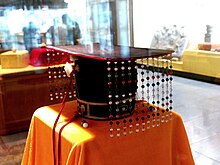Mian guan

The Miang guan ( Chinese 冕 冠 , Pinyin Miǎn guān ) was the traditional headgear of Chinese rulers, other nobles, ministers and high officials until late antiquity, as well as an insignia of power. It was still worn during the Sui Dynasty and even occasionally in the Ming Dynasty - for example by Wanli . Detailed descriptions can be found in the rites of the Zhou and the Book of Rites . It is said that the Miǎn guān was forbidden by Qin Shihuangdi - the first emperor and one of the empire. Nevertheless, he can be seen wearing this hat on numerous, mostly posthumous depictions. Even in the Western Han Dynasty , headgear was probably not in use.
The main component was a flat, wooden plate covered with fabric, which protruded over the head with an angular front and rounded back. Several cords with threaded beads were attached to both narrow sides. The number of strings of pearls indicated the position of the wearer in the social power structure: the more influential he was, the more threads his hat had. Only twelve strings were reserved for the emperor on both sides; Princes had nine. Usually the hats were tied with a ribbon under the chin and fixed to the hair with a jade clip . A narrow ribbon of fabric ran across the Miǎn guān and hung down on both sides; it symbolized the Milky Way . The wooden plate also had a deeper symbolism: the angular end should represent the earth, the rounded end the sky. The front strings of pearls represented the future times towards which the ruler was walking, the back ones for the past, from which one can never completely break away.
Variants of the Miǎn guān were also known in Japan , Vietnam and the Korean peninsula .